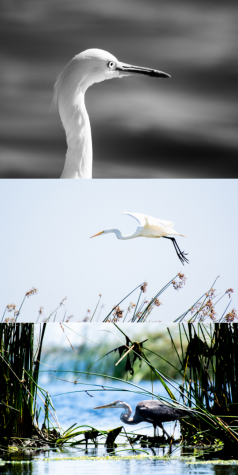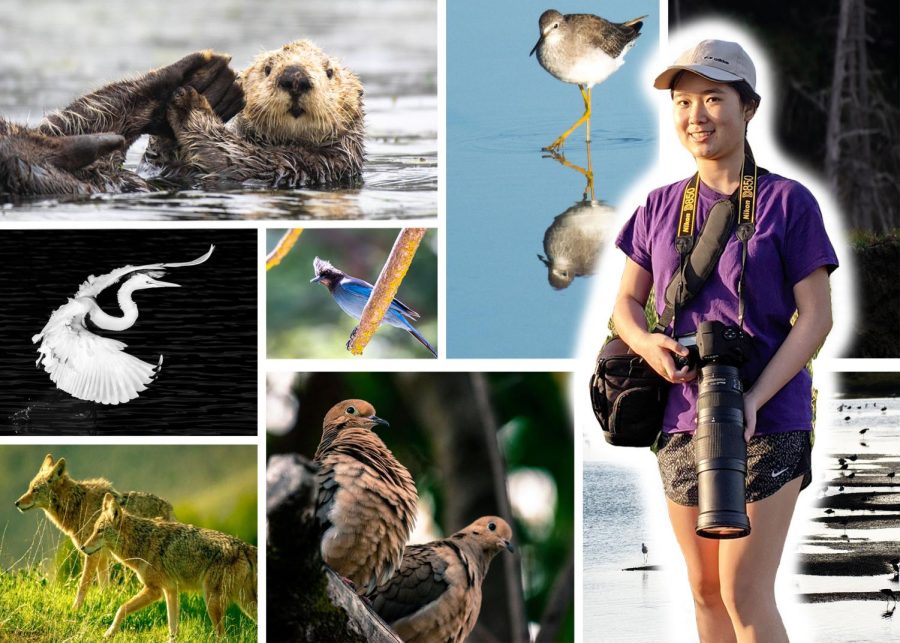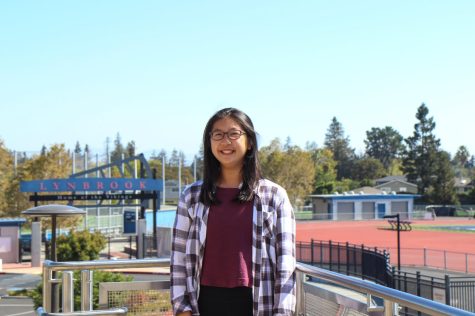Capturing the moment: Senior Carol Gao’s wildlife photography
Photos by Carol Gao; graphic illustration by Sophie Au
Gao takes photos of various wildlife in different environments using her photography equipment.
November 4, 2020
Crouched down on a kayak with a five-pound camera lens, senior Carol Gao observes as birds fly nearby and occasionally swoop down to the lake’s surface. She snaps a photo, but it is blurry. She snaps a second one, but it is partly out of frame. An hour and innumerable attempts later, she captures the perfect photo. Waiting hours on end for an exciting action shot is typical for Gao, who enjoys wildlife photography in her free time.
“Ever since I had a phone with a camera, I’d take pictures of my friends or flowers,” Gao said. “Then in my sophomore year, I took Lynbrook’s photography class. That’s when I had more experience with a camera and when I realized that I can play around with the settings to achieve something beyond how it appears in my eyes.”
Gao has always loved animals, so naturally she started by photographing pictures of animals around her neighborhood such as caterpillars and birds, then moved onto animals farther away from home in the wilderness. After years of experimenting with taking photos of different subjects, Gao found wildlife photography to be her favorite.
“Photography another perspective of observing details and movements that you were not able to see through your eyes,” Gao said. “You can’t really see a particular moment because it passes by so fast. Our eyes only have shutter speeds of 1/125 of a second. By adjusting the shutter speed of my camera — usually, I like using 1/1600 or 1/2500 for bird photography — I’ll capture the exact motion in time.”
In addition to taking photos of wildlife in her community, Gao travels to places like Monterey Bay to take photos of marine wildlife. It can easily take as long as two hours to get the perfect photo. Carrying a heavy camera and lenses while kayaking through the bay to find wildlife can be extremely challenging but rewarding.
By the end of the day, my hands and my arms are so tight and sore,” Gao said. “But in the moment, you just lose track of time.”
After taking numerous pictures, Gao must carefully select the best one. She looks for photos with the best lighting, texture and color. She also considers which photos which clearly send a message to her audience.

“It looks different — when you see it, you are drawn to what’s happening in the photo, whether it’s tensions, contrasts or interesting details, and you just like it,” Gao said. “Outstanding photos are the ones that make you think about the shapes, compositions and messages. Even after hours of looking at the photo, you’ll still love it.”
After picking, Gao spends several hours editing the photo to make it look the best. She adjusts the lighting and color of the photos , and crops them so they focus on only the animal. Black-and-white photos help to emphasize the shape and texture of a specific animal, and altering the lighting can emphasize texture as well. With photographing, picking and editing, publishing a wildlife photo can take days or even weeks.
Sometimes, Gao goes back and edits older photos as she develops the skills necessary to transform them to a professional level. She keeps all her photos organized and filed away so that she can find old photos to edit.
After photographing a variety of animals from birds to coyotes, Gao has her favorites.
“Personally, I love the egrets because they are beautiful, their postures are elegant, and their shapes (beaks and necks) are clearly outlined,” Gao said. “But I think the cutest animals are the sea otters. They are fluffy and adorable when they groom their furs.”
Gao has continued to take photos of wildlife around her community this past months and will continue to do so. In the future, she hopes to travel to Alaska and Africa to take pictures of unique animals she hasn’t had the chance to capture on film yet. Gao encourages aspiring photographers to persevere and take risks.
“Go out, try a lot, and never be discouraged,” Gao said. “Press the shutter of the camera and take a lot of photos. If you have the opportunity, you should participate in photo critiques so you will receive inspirations and suggestions. Through practice and analysis, you will know which ones are good, what areas you should improve on, and what lightings and backgrounds you should look for in your future shots.”




























































